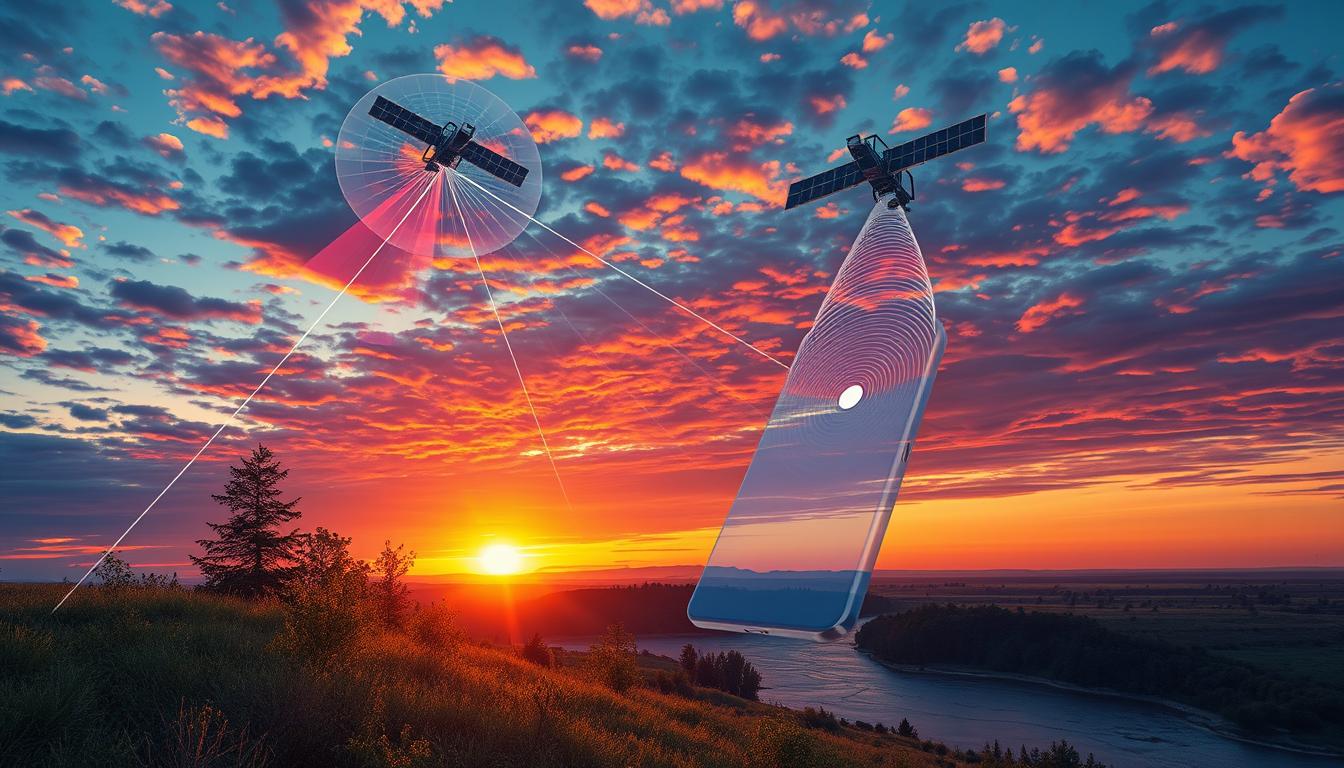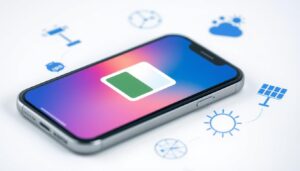Vodafone has made a huge leap in mobile network technology. They’ve made the world’s first video call using standard 4G and 5G smartphones1. This breakthrough could change how we talk to each other around the globe, making it easier to connect in places without signal1.
This historic call happened in a remote area in mid-Wales. This place usually has no mobile broadband1. Thanks to Vodafone’s new satellite tech, people can now make video calls, browse the internet, and send messages from almost anywhere1.
This achievement is special because it works with regular smartphones. Vodafone’s satellite service is the only one that does this worldwide1. The BlueBird satellites, flying low in the sky, are a big step forward in satellite tech1.
Key Takeaways
- First-ever space video call using standard smartphones
- Connectivity in previously unreachable remote locations
- No special equipment required for satellite communication
- Peak data transmission speeds up to 120 Mbps
- Potential to bridge digital connectivity gaps worldwide
Groundbreaking Achievement in Satellite Communication
Vodafone has made a huge leap in satellite communication. They made the first video call using standard smartphones through satellite tech2. This is a big step forward for internet access in remote places3.
This new method doesn’t need special gear like satellite phones or big dishes. Vodafone’s team showed that 4G/5G tech can work through low Earth orbit satellites2.
First-Ever Space Video Call Details
Vodafone engineer Rowan Chesmer made the call from a remote spot in mid-Wales. This area had no mobile broadband before3. The call showed how to connect places that are hard to reach2.
Technology Behind the Innovation
The success comes from AST SpaceMobile’s BlueBird satellites. They can send data up to 120 Mbps straight to phones2. This tech works well with current cell networks, making it a full solution3.
Impact on Global Connectivity
Vodafone is closing the digital gap by reaching remote areas. Their satellite service offers steady communication in emergencies and where usual networks fail3.
How Vodafone’s Satellite Technology Works

I’m excited to dive into Vodafone’s new satellite tech. It’s changing how we connect with the internet. This tech lets phones use satellite signals, making mobile internet better everywhere4.
The heart of this tech is AST SpaceMobile’s BlueBird satellites. They’re in low Earth orbit, covering 700 square feet each, about 500 kilometers up5. This lets phones connect in places without normal internet.
“We’re bridging the connectivity gap with revolutionary satellite technology,” says a Vodafone spokesperson.
This tech is special because it offers fast mobile data. It uses advanced tech to reach speeds up to 120 megabits per second5. Vodafone aims to use many satellites to cover all of Europe by 20264.
The future of global connectivity is here, with Vodafone’s satellite technology promising to close mobile network gaps and bring digital solutions to the most remote corners of Europe by 20264.
Partnership with AST SpaceMobile and Future Implementation
Vodafone has teamed up with AST SpaceMobile in a big move. This partnership aims to change how we connect globally. It uses satellite tech to improve customer support and roaming services6.

Vodafone has put in a lot of money. They’ve invested $35 million in AST SpaceMobile. With other big names like AT&T and Google, the total investment is $155 million7. This shows how promising satellite communication is6.
Investment and Development Timeline
We have big plans for launching satellites. First, we aimed for 20 satellites by September 2023. But now, we’re launching 5 in Q1 2024. The first 5G call from space hit a download speed of 14 Mbps6.
Commercial Launch Plans
Vodafone wants to bring satellite broadband to 24 countries. We’re aiming for a launch in 2025-2026. This will help improve services in areas with poor connectivity6.
European Market Strategy
In Europe, we’re working to fill communication gaps. With AST SpaceMobile’s tech, we’ll offer smooth connections in remote spots. This will change how people use mobile services7.
Conclusion
Vodafone’s satellite technology breakthrough is a game-changer for global connectivity. Our goal to connect everyone, no matter where they are, has made a huge leap forward8. This innovation means we can now talk and share information in places that were once unreachable.
Our partnership with AST SpaceMobile marks a new chapter for Vodafone’s tech. We’re making it possible to use satellite connectivity with regular phones. This opens up new chances for people who were cut off from the world8.
I’m thrilled about what this technology can do for people’s lives. We’re not just making mobile networks better. We’re creating ways for people to grow and thrive in tough places9.
Vodafone is leading a communication revolution. We’re ready to bring connectivity to everyone, everywhere. Our goal for 2025-2026 is to make sure no one is left behind in our digital world.
FAQ
What makes Vodafone’s satellite connectivity unique?
Vodafone’s technology lets you make video calls from anywhere using just your phone. No special gear is needed. It combines satellites with 4G and 5G networks, making it a big leap forward.
How does the satellite technology work with standard smartphones?
AST SpaceMobile BlueBird satellites connect directly to your phone. They work with regular mobile devices, so you don’t need special phones or extra hardware.
When will this satellite communication service be commercially available?
Vodafone and AST SpaceMobile aim to launch it in 2025 or 2026. They’re starting in Europe first. They’ve been working on it for six years, getting ready for a big rollout.
What are the possible uses of this satellite technology?
It’s huge for IoT and digital solutions. It’s a game-changer for reaching remote areas. It brings strong wireless connections to places that were hard to reach before.
Will this service change how we use international roaming?
Yes, it will. This tech will make roaming better by keeping you connected everywhere. It’s great for travelers and remote workers, making communication easier.
How does this differ from old satellite services?
Vodafone’s service works with your phone and mobile networks. It doesn’t need special gear. It’s faster and easier to use than old satellite services.
What technical challenges did Vodafone face?
Vodafone overcame big technical challenges. They made satellites that talk to regular phones and ensured fast, reliable connections.
How will this technology change global connectivity?
It’s a big deal for connecting remote places. It’s a step towards making sure everyone has internet and phone access. It’s a big move towards digital inclusion.
Source Links
- Vodafone makes world’s first space video call from an area of no coverage using a standard mobile phone and commercial satellites built to offer a full mobile broadband experience
- Vodafone makes history with first space video call using regular smartphones
- Vodafone and AST SpaceMobile Achieve Historic Satellite-Powered Video Call
- Vodafone makes ‘world’s first’ satellite video call from a regular phone ahead of 2025 rollout
- Direct-to-smartphone satellite service: everything you need to know
- Vodafone-backed AST SpaceMobile gets $155m funding booster
- AST SpaceMobile bags $155 mn strategic investment from AT&T, Google, Vodafone – ET Telecom | Satcom
- Vodafone Idea says set-up 100 towers every hour post-conclusion of FPO – ET Telecom
- Vodafone & Idea: Revolutionizing India’s Telecom Landscape







